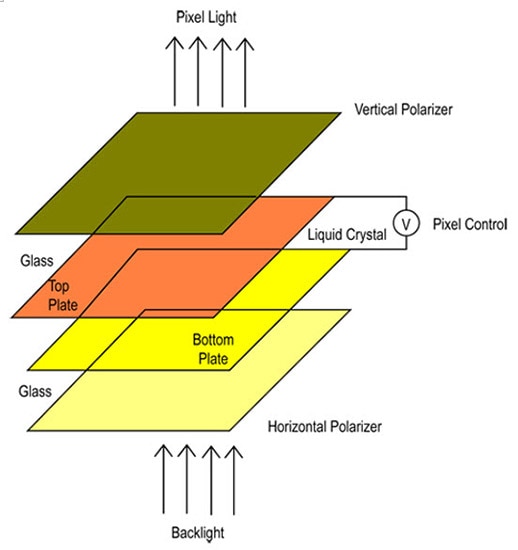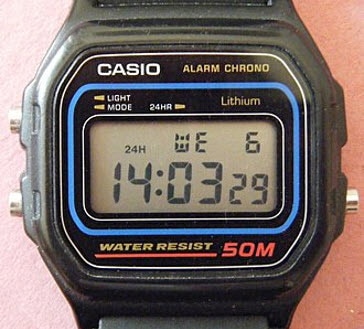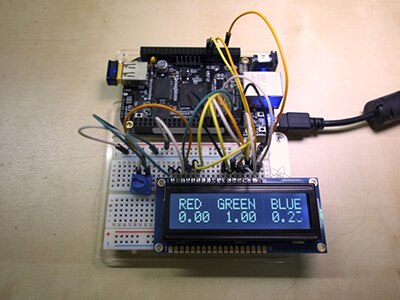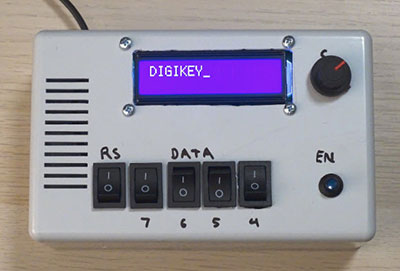What Even is an LCD??
2023-12-29 | By Antonio Velasco
One of the most common terms you’ll hear when picking out a digital display or something to display an output is LCD or Liquid Crystal Display. I’ve heard this term over and over again and incorporated them into a few projects, but up until a few months ago, I had no idea what it even was. I've been using the same LCD with an I2C backpack for quite a while, shown below, which I'll go over how to use in a second article! For now, I think it’s fair that we shed some "light" on this thing.

What is a Liquid Crystal?
LCDs are simply made out of, surprise surprise, liquid crystals! However, you may be shocked to find out that liquid crystals are not liquids—in fact, they aren’t even solids! They’re actually a sort of Frankenstein mixture between the two phases of matter, being thermodynamically stable with characteristics of both. The molecules within them are aligned in the same order as crystals, and as a result, possess the same anisotropic properties of a crystal while lacking the crystal lattice, making it mobile like a liquid. These molecules are typically shaped like a rod and elongated. They can change their alignment or polarization based on the electric field applied.
How Does the LCD work?
LCDs consist of a number of layers, which we’ll go over one by one. You can imagine it sort of like a wafer cookie, with sheets placed on top of each other.

- The Backlight is the first layer in the display, producing the light and thus, the visible image. LCDs are a type of “backlit” display, meaning that the components within it don’t actually produce any light and require an external source to produce the light. Certain films or sheets can be applied to the backlight to optimize it.
- The Polarizing Film is the next layer in the puzzle. These polarizers are placed both on the bottom and on the top of the liquid crystal layer. One polarizer will be placed with its “folds” orienting toward one direction and the other towards the other. If you were to stack them onto each other, all the “folds” would intersect perpendicularly. This comes into play with the purpose of the polarizing film since the “folds,” or parts where the lights would pass through, only allow light that is vibrating in a certain direction. So, if both filters were on and thus perpendicular to each other, no light passes through.
- The Negative Electrode follows the film, applying the electric field to the centerpiece, the liquid crystal layer. Differing electric fields allow us to control the orientation of the liquid crystal molecules, thus modulating the light that passes through. The negative electrode typically is below the liquid crystal display, and the positive electrode is over it. Sometimes, a Thin-Film Transistor (TFT) will be applied next to the electrodes and control the voltage applied allowing for greater precision and maintenance of each pixel state.
- The Liquid Crystal Layer is the center layer and the crown jewel of it all. This is where the magic happens. As previously mentioned, when electric fields are applied to liquid crystals, the orientation of its molecules will be altered, and thus the polarization of light changes. This modulated light, in turn, creates the display’s images.
- On top of the Liquid Crystal Layer, we’ll have the positive electrode, then any color filters, followed by the opposite polarizing film, and finally, the glass, showing the displayed image at the very top.
The order may sometimes differ depending on the type of LCD, and oftentimes there’ll be additional color or glass substrate layers, but all LCDs will have the aforementioned parts: a backlit/mirror layer, polarizing film, positive/negative electrode, and a liquid crystal layer.
Further Discussion
To put it all together, light will first be sent up from the backlight. The first polarizing film, typically vertical, only let’s light that is vibrating vertically pass through. The liquid crystal in between can modulate, or “twist” this light, depending on the electric field applied by the electrodes. The orientation that the light is twisted matters as we come to the next polarizing film, if the vertically polarized light remains untwisted, it will not pass through. Similarly, if we do twist the vertically polarized light to a horizontally polarized orientation, then light will pass through the horizontal polarizer.
This all comes together in the LCD as the backlight produces constant light, and when the liquid crystal is twisted to let the light through, nothing appears. However, when a voltage is applied to the liquid crystal, and we let no light through, a black pixel will appear, thus creating an image.
This is also why it’s harder to see LCDs when in a super bright environment, like when you’re outside. The black pixels that you see are merely just an absence of light, and when you’re somewhere with a ton of light, there simply is no absence of light.

Think of when you're using a digital watch--when you're outside you can't always see the numbers!
So, there you have it! A little peek into the world of LCDs. The science behind it gets much more complex and subsequently interesting, but this should give you a little rundown on how those mass-produced plastic displays are everywhere.









